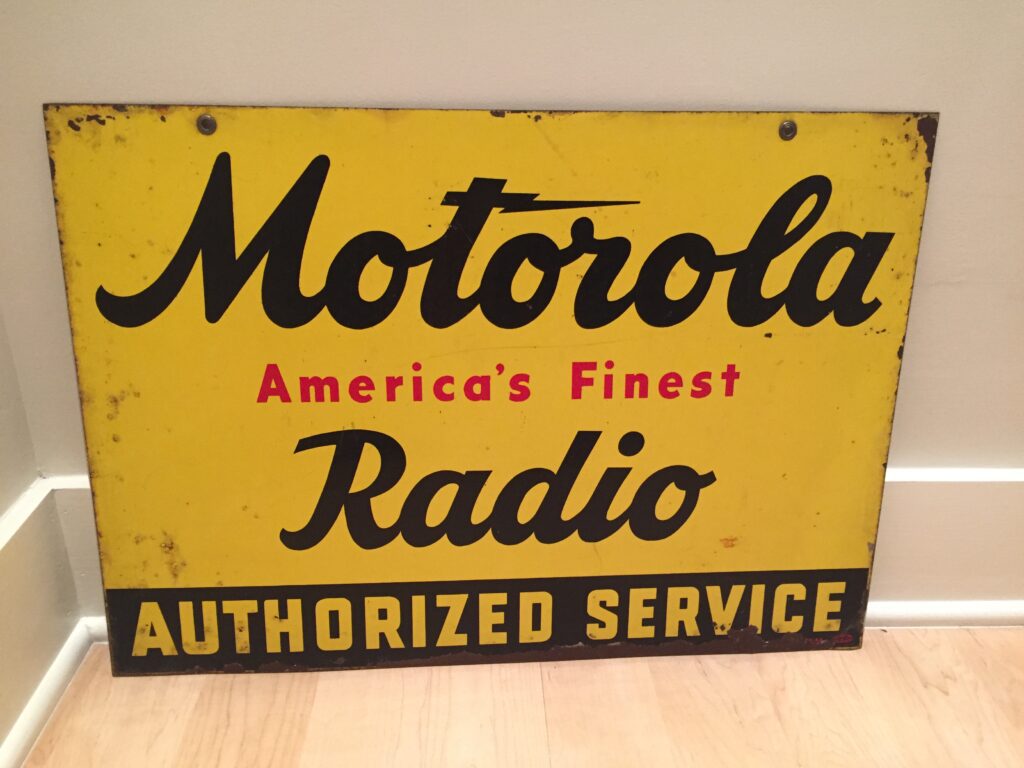The history of communications in the US over the past 100 years is absolutely littered with products that were either invented or perfected by Motorola: the car radio, for starters, but also the walkie-talkie, the pager, the cell phone, and, thanks to Motorola’s work with NASA, the “first car radio on the moon.”

I grew up in the western suburbs of Chicago, not too far from Motorola’s headquarters in Schaumburg, IL. My dad worked as an attorney for Motorola for 21 years. Myself, I worked in the Motorola Law Department for two summers while I was in law school. So it’s fair to say that my family has some pretty strong connections to Motorola.
I am always looking for interesting music- and audio-themed artwork for the hallways of the studio. Vintage stuff is cool if you can find it, but there’s not nearly as much “studio-themed” stuff in the world of vintage artwork as there are other for other products such as motor oil, Coca-Cola or other consumer products stuff. Why? I suspect because at the time recording studios were simply not a major consumer product or service. Oil companies provided all sorts of artwork to gas stations to help draw attention to their products; companies that made baked goods, soda, cigarettes, and any number of other items you’d find at a grocery store did the same thing. Recording studios were not really going after that kind of a market.

Vinyl records, along with radio and television shops, though, WERE consumer products and DID target end customers with advertising. The best known example of this sort of advertising, probably, is Nipper, RCA Victor’s famous dog, listening to “His Master’s Voice” emanating from the Victrola. Vintage signs featuring Nipper and the record player fetch a huge premium among collectors — so much so that an original Nipper sign is probably not something I’d ever consider owning.
That said, a while back I came across a reasonably-priced bit of audio-themed memorabilia on eBay: a “Motorola Radio Authorized Service” sign. Since my family has long ties to Motorola, I added it to my collection.
The seller didn’t provide any information about how old this sign was, so I did a little poking around to see what I could discover. Motorola’s familiar “batwing” logo was introduced back in 1955, so this sign predates it by some amount (as an aside, I am endlessly fascinated by the fact that the Motorola batwing has been in continuous use for over 60 years and yet still seems futuristic to a modern viewer). From what I can tell from other ads from the period, I estimate this sign is from the postwar era, most likely 1948 or so.
I have mounted the sign at the top of the stairwell as you go down to the studio. I’m hoping, over time, to add more pieces to the stairway and lobby area. Strictly speaking, I’m not pushing to have *everything* be audio-themed (we’ve got some cool memorabilia from the Hard Times Cafe restaurant that recently closed down already hanging in the stairwell), but I’m also trying to avoid looking too much like your typical rumpus room/man cave, with road signs, beer signs, and motor oil ads. So this is a good addition and definitely fits with the “theme.”

The company has had several sad chapters in the past 25 years. Motorola doubled down on its analog cellular business in the mid-1990s, at a time when digital was taking over — a decision that resulted in competitors such as Ericsson and Nokia largely eating the company’s lunch in the cellular market. It designed and built the Iridium satellite system to provide anywhere-on-earth telecommunications capabilities, only to have the system go bankrupt and later find success after the U.S. government provided a $72 million contract to allow a group of investors to buy the service out of bankruptcy court. when Motorola sold it for pennies on the dollar. Ultimately, Motorola lost $4.3 billion between 2007 and 2009, which led to the company splitting itself into two parts in 2011. Motorola Mobility (now part of Google) is the successor to Motorola’s cell phone business, while Motorola Solutions, Inc. carried on Motorola’s traditional businesses in public sector telecommunications for police, fire and government agencies (the famous “alert tones” heard on the old “Emergency!” TV series came from one such Motorola system).
So while “today’s Motorola” is nothing like the company used to be, for me, the sign is nevertheless a fun reminder of our long association with the company.
Share this:
- Click to email a link to a friend (Opens in new window) Email
- Click to share on X (Opens in new window) X
- Click to share on Facebook (Opens in new window) Facebook
- Click to share on LinkedIn (Opens in new window) LinkedIn
- Click to share on Pinterest (Opens in new window) Pinterest
- Click to print (Opens in new window) Print


